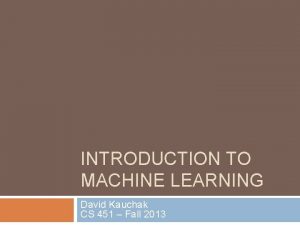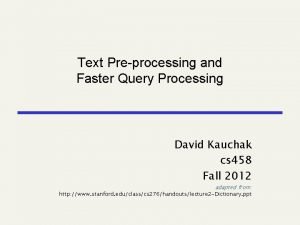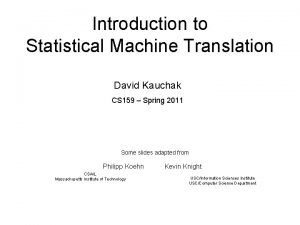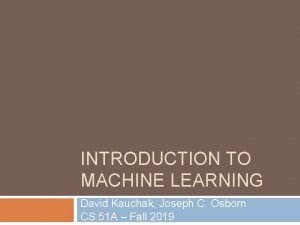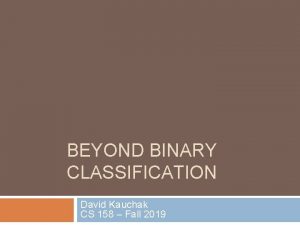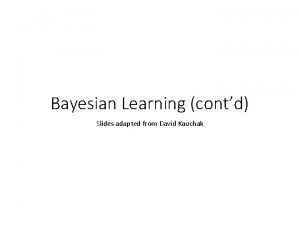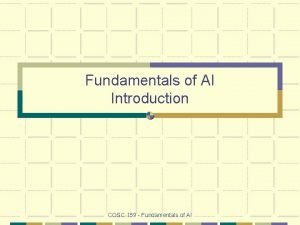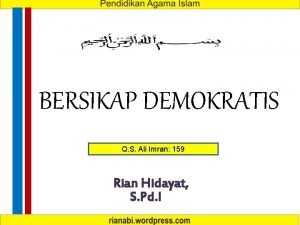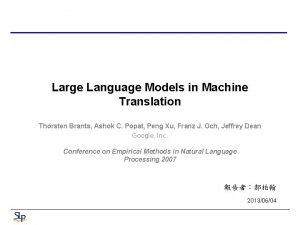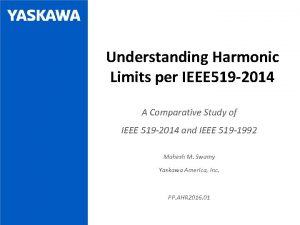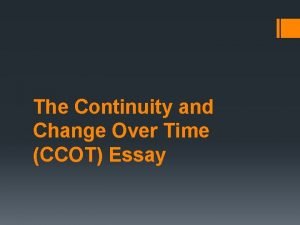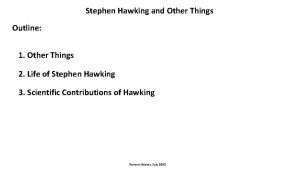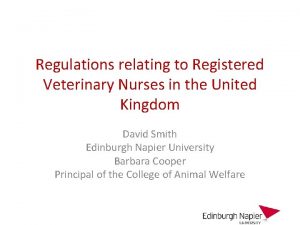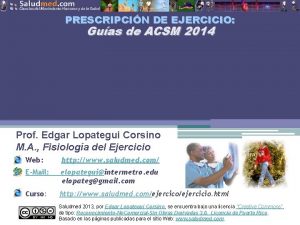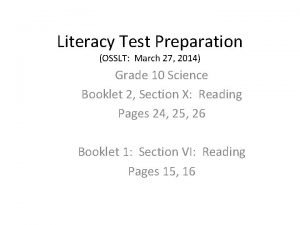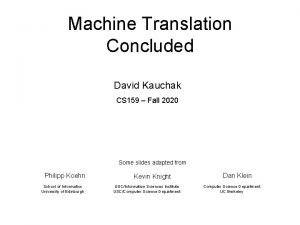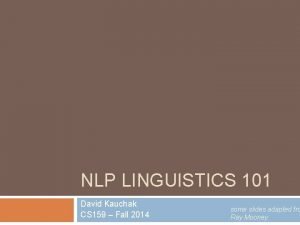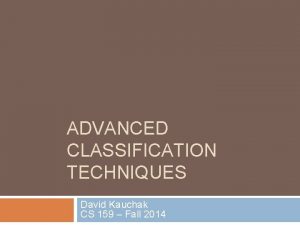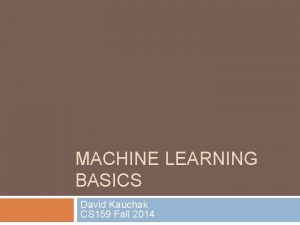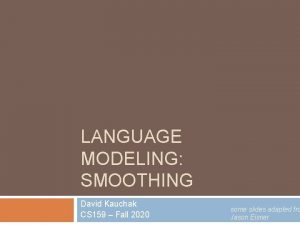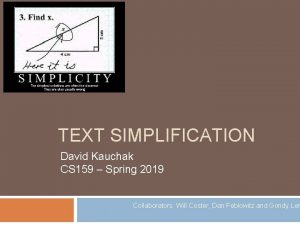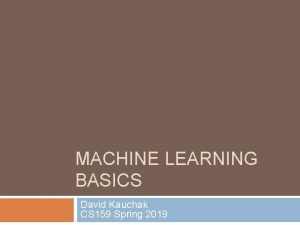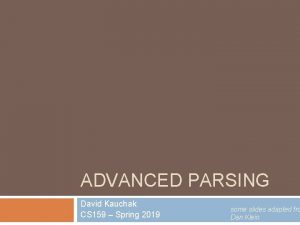Translation Models David Kauchak CS 159 Fall 2014

























































- Slides: 57

Translation Models David Kauchak CS 159 – Fall 2014 Some slides adapted from Philipp Koehn School of Informatics University of Edinburgh Kevin Knight USC/Information Sciences Institute USC/Computer Science Department Dan Klein Computer Science Department UC Berkeley

Admin Assignment 5 • extended to Thursday at 2: 45 – Should have worked on it some already! – Extra credit (5%) if submitted by Tuesday (i. e. now) – No late days

Language translation Yo quiero Taco Bell

Noisy channel model translation model how do English sentences get translated to foreign? language model what do English sentences look like?

Problems for Statistical MT Preprocessing – How do we get aligned bilingual text? – Tokenization – Segmentation (document, sentence, word) Language modeling – Given an English string e, assigns P(e) by formula Translation modeling – Given a pair of strings <f, e>, assigns P(f | e) by formula Decoding – Given a language model, a translation model, and a new sentence f … find translation e maximizing P(e) * P(f | e) Parameter optimization – Given a model with multiple feature functions, how are they related? What are the optimal parameters? Evaluation – How well is a system doing? How can we compare two systems?

Problems for Statistical MT Preprocessing Language modeling Translation modeling Decoding Parameter optimization Evaluation

From No Data to Sentence Pairs Easy way: Linguistic Data Consortium (LDC) Really hard way: pay $$$ – Suppose one billion words of parallel data were sufficient – At 20 cents/word, that’s $200 million Pretty hard way: Find it, and then earn it! How would you obtain data? What are the challenges?

From No Data to Sentence Pairs Easy way: Linguistic Data Consortium (LDC) Really hard way: pay $$$ – Suppose one billion words of parallel data were sufficient – At 20 cents/word, that’s $200 million Pretty hard way: Find it, and then earn it! – – – De-formatting Remove strange characters Character code conversion Document alignment Sentence alignment Tokenization (also called Segmentation)

What is this? 49 20 6 c 69 6 b 65 20 4 e 4 c 50 20 63 6 c 61 73 73 I _ l i k e _ N L P _ c l a s s Hexadecimal file contents Totally depends on file encoding!

ISO-8859 -2 (Latin 2) ISO-8859 -6 (Arabic)

Chinese? • • • GB Code GBK Code Big 5 Code CNS-11643 -1992 …

If you don’t get the characters right…

Document Alignment Input: – Big bag of files obtained from somewhere, believed to contain pairs of files that are translations of each other. E E C C E C E E C C C E Output: – List of pairs of files that are actually translations. C

Document Alignment Input: – Big bag of files obtained from somewhere, believed to contain pairs of files that are translations of each other. E E C C E C E E C C C E Output: – List of pairs of files that are actually translations. C

Sentence Alignment The old man is happy. He has fished many times. His wife talks to him. The fish are jumping. The sharks await. El viejo está feliz porque ha pescado muchos veces. Su mujer habla con él. Los tiburones esperan.

Sentence Alignment 1. The old man is happy. 2. He has fished many times. 3. His wife talks to him. 4. The fish are jumping. 5. The sharks await. 1. El viejo está feliz porque ha pescado muchos veces. 2. Su mujer habla con él. 3. Los tiburones esperan. What should be aligned?

Sentence Alignment 1. The old man is happy. 2. He has fished many times. 3. His wife talks to him. 4. The fish are jumping. 5. The sharks await. 1. El viejo está feliz porque ha pescado muchos veces. 2. Su mujer habla con él. 3. Los tiburones esperan.

Sentence Alignment 1. The old man is happy. He has fished many times. 2. His wife talks to him. 3. The sharks await. 1. El viejo está feliz porque ha pescado muchos veces. 2. Su mujer habla con él. 3. Los tiburones esperan. Note that unaligned sentences are thrown out, and sentences are merged in n-to-m alignments (n, m > 0).


Problems for Statistical MT Preprocessing Language modeling Translation modeling Decoding Parameter optimization Evaluation

Language Modeling Most common: n-gram language models More data the better (Google n-grams) Domain is important

Problems for Statistical MT Preprocessing Language modeling Translation modeling Decoding Parameter optimization Evaluation

Translation Model Want: probabilistic model gives us how likely one sentence is to be a translation of another, i. e p(foreign | english) Mary did not slap the green witch Maria no dió una botefada a la bruja verde Can we just model this directly, i. e. p(foreign | english) ? How would we estimate these probabilities, e. g. p( “Maria …” | “Mary …”)?

Translation Model Want: probabilistic model gives us how likely one sentence is to be a translation of another, i. e p(foreign | english) Mary did not slap the green witch Maria no dió una botefada a la bruja verde p( “Maria…” | “Mary…” ) = count(“Mary…” aligned-to “Maria…”) count( “Mary…”) Not enough data for most sentences!

Translation Model Key: break up process into smaller steps Mary did not slap the green witch sufficient statistics for smaller steps Maria no dió una botefada a la bruja verde

What kind of Translation Model? Mary did not slap the green witch Word-level models Phrasal models Syntactic models Semantic models Maria no dió una botefada a la bruja verde

IBM Word-level models Mary did not slap the green witch Word-level model Maria no dió una botefada a la bruja verde Generative story: description of how the translation happens 1. Each English word gets translated as 0 or more Foreign words 2. Some additional foreign words get inserted 3. Foreign words then get shuffled

IBM Word-level models Mary did not slap the green witch Word-level model Maria no dió una botefada a la bruja verde Each foreign word is aligned to exactly one English word. Key idea: decompose p( foreign | english ) into word translation probabilities of the form p( foreign_word | english_word ) IBM described 5 different levels of models with increasing complexity (and decreasing independence assumptions)

Some notation English sentence with length |E| Foreign sentence with length |F| Mary did not slap the green witch Maria no dió una botefada a la bruja verde Translation model:

Word models: IBM Model 1 Mary did not slap the green witch p(verde | green) Maria no dió una botefada a la bruja verde Each foreign word is aligned to exactly one English word This is the ONLY thing we model! Does the model handle foreign words that are not aligned, e. g. “a”?

Word models: IBM Model 1 NULL Mary did not slap the green witch p(verde | green) Maria no dió una botefada a la bruja verde Each foreign word is aligned to exactly one English word This is the ONLY thing we model! Include a “NULL” English word and align to this to account for deletion

Word models: IBM Model 1 generative story -> probabilistic model – Key idea: introduce “hidden variables” to model the word alignment • one variable for each foreign word • ai corresponds to the ith foreign word • each ai can take a value 0…|E|

Alignment variables Mary did not slap the green witch Maria no dió una botefada a la bruja verde a 1 1 a 2 3 a 3 4 a 4 4 a 5 4 a 6 0 a 7 5 a 8 7 a 9 6

Alignment variables And the program has been implemented Alignment? Le programme a ete mis en application

Alignment variables And the program has been implemented Le programme a ete mis en application a 1 ? a 2 ? a 3 ? a 4 ? a 5 ? a 6 ? a 7 ?

Alignment variables And the program has been implemented Le programme a ete mis en application a 1 2 a 2 3 a 3 4 a 4 5 a 5 6 a 6 6 a 7 6

Probabilistic model ? = NO! How do we get rid of variables?

Joint distribution NLPPass, Eng. Pass P(NLPPass, Eng. Pass) true, true . 88 true, false . 01 false, true . 04 false, false . 07 What is P(ENGPass)?

Joint distribution NLPPass, Eng. Pass P(NLPPass, Eng. Pass) true, true . 88 true, false . 01 false, true . 04 false, false . 07 0. 92 How did you figure that out?

Joint distribution Called “marginalization”, aka summing over a variable NLPPass, Eng. Pass P(NLPPass, Eng. Pass) true, true . 88 true, false . 01 false, true . 04 false, false . 07

Probabilistic model Sum over all possible values, i. e. marginalize out the alignment variables

Independence assumptions IBM Model 1: What independence assumptions are we making? What information is lost?

And the program has been implemented Le programme a ete mis en application Are the probabilities any different under model 1? And the program has been implemented application en programme Le mis ete a

And the program has been implemented Le programme a ete mis en application No. Model 1 ignores word order! And the program has been implemented application en programme Le mis ete a

IBM Model 2 NULL Mary did not slap the green witch p(la|the) Maria no dió una botefada a la verde bruja p(i aligned-to ai) Maria no dió una botefada a la bruja verde Models word movement by position, e. g. • Words don’t tend to move too much • Words at the beginning move less than words at the end

IBM Model 3 NULL Mary did not slap the green witch Mary not slap the green witch p(3|slap) p(la|the) Maria no dió una botefada a la verde bruja p(i aligned-to ai) Maria no dió una botefada a la bruja verde Incorporates “fertility”: how likely a particular English word is to produce multiple foreign words

Word-level models Problems/concerns? – Multiple English words for one French word • IBM models can do one-to-many (fertility) but not many-toone – Phrasal Translation • “real estate”, “note that”, “interest in” – Syntactic Transformations • Verb at the beginning in Arabic • Translation model penalizes any proposed re-ordering • Language model not strong enough to force the verb to move to the right place

Benefits of word-level model Rarely used in practice for modern MT systems Why talk about them? Mary did not slap the green witch Maria no dió una botefada a la bruja verde Two key side effects of training a word-level model: • Word-level alignment • p(f | e): translation dictionary

Training a word-level model Where do these come from? Have to learn them! The old man is happy. He has fished many times. His wife talks to him. The sharks await. … El viejo está feliz porque ha pescado muchos veces. Su mujer habla con él. Los tiburones esperan. …

Training a word-level model The old man is happy. He has fished many times. His wife talks to him. The sharks await. … El viejo está feliz porque ha pescado muchos veces. Su mujer habla con él. Los tiburones esperan. … : probability that e is translated as f How do we learn these? What data would be useful?

Thought experiment The old man is happy. He has fished many times. El viejo está feliz porque ha pescado muchos veces. His wife talks to him. The sharks await. Su mujer habla con él. Los tiburones esperan. ?

Thought experiment The old man is happy. He has fished many times. El viejo está feliz porque ha pescado muchos veces. His wife talks to him. The sharks await. Su mujer habla con él. Los tiburones esperan. p(el | the) = 0. 5 p(Los | the) = 0. 5 Any problems concerns?

Thought experiment The old man is happy. He has fished many times. El viejo está feliz porque ha pescado muchos veces. His wife talks to him. The sharks await. Su mujer habla con él. Los tiburones esperan. Getting data like this is expensive! Even if we had it, what happens when we switch to a new domain/corpus

Training without alignments ab x y How should these be aligned? cb z x There is some information! (Think of the alien translation task last time)

Thought experiment #2 The old man is happy. He has fished many times. Annotator 1 El viejo está feliz porque ha pescado muchos veces. The old man is happy. He has fished many times. Annotator 2 El viejo está feliz porque ha pescado muchos veces. What do we do?

Thought experiment #2 The old man is happy. He has fished many times. 80 annotators El viejo está feliz porque ha pescado muchos veces. The old man is happy. He has fished many times. 20 annotators El viejo está feliz porque ha pescado muchos veces. What do we do?

Thought experiment #2 The old man is happy. He has fished many times. 80 annotators El viejo está feliz porque ha pescado muchos veces. The old man is happy. He has fished many times. 20 annotators El viejo está feliz porque ha pescado muchos veces. Use partial counts: - count(viejo | man) 0. 8 - count(viejo | old) 0. 2
 David kauchak
David kauchak Lebensversicherungsgesellschaftsangestellter
Lebensversicherungsgesellschaftsangestellter David kauchak
David kauchak David kauchak
David kauchak David kauchak
David kauchak David kauchak
David kauchak David kauchak
David kauchak Introduction to teaching kauchak
Introduction to teaching kauchak Father of italian sonnet
Father of italian sonnet Ai 159
Ai 159 Iso tc 159
Iso tc 159 Page 159
Page 159 159 ap
159 ap Cs 159
Cs 159 Surah ali imran 159
Surah ali imran 159 Mokena school district calendar
Mokena school district calendar Infrastrukturmaster und globaler katalog
Infrastrukturmaster und globaler katalog Modul 159
Modul 159 P 159
P 159 Iso tc 159
Iso tc 159 Fas 107
Fas 107 Route 159
Route 159 Modals and semi modals
Modals and semi modals Thorsten brants
Thorsten brants Communicative translation
Communicative translation Cisco voice translation-rule
Cisco voice translation-rule Parent transformations
Parent transformations Noun phrase
Noun phrase Teacher twins 2014
Teacher twins 2014 Integrated people-centred health services
Integrated people-centred health services Teacher twins@2014
Teacher twins@2014 Ddb board regulation #1 s. 2014
Ddb board regulation #1 s. 2014 Ieee 519 harmonic limits
Ieee 519 harmonic limits Continuity and change thesis
Continuity and change thesis Delinquency report system
Delinquency report system Hawking
Hawking 2014 special olympics
2014 special olympics Principles of the social services and wellbeing act
Principles of the social services and wellbeing act Social services and wellbeing (wales) act 2014 easy read
Social services and wellbeing (wales) act 2014 easy read Agosto 2014
Agosto 2014 Sfc 2014
Sfc 2014 Orden 3814/2014
Orden 3814/2014 Trados studio 2014
Trados studio 2014 Riverbed gartner magic quadrant 2020
Riverbed gartner magic quadrant 2020 Enade 2014
Enade 2014 Veterinary nurse conduct and discipline rules 2014
Veterinary nurse conduct and discipline rules 2014 Enade 2014
Enade 2014 Determining proportionality with tables
Determining proportionality with tables Acsm 2014
Acsm 2014 Skala gred spm 2013
Skala gred spm 2013 Siklus pengelolaan aset pada pp 27 tahun 2014
Siklus pengelolaan aset pada pp 27 tahun 2014 Patientlagen 2014:821
Patientlagen 2014:821 Orden del 16 de junio de 2014
Orden del 16 de junio de 2014 Numa competição esportiva cinco atletas
Numa competição esportiva cinco atletas Microsoft word 2014
Microsoft word 2014 Powerpoint 2014
Powerpoint 2014 Osslt 2014 answer key
Osslt 2014 answer key Omen 4435 din 2014
Omen 4435 din 2014
